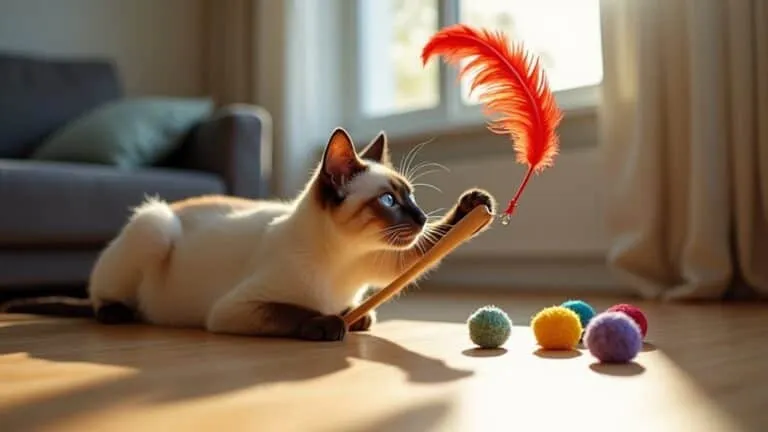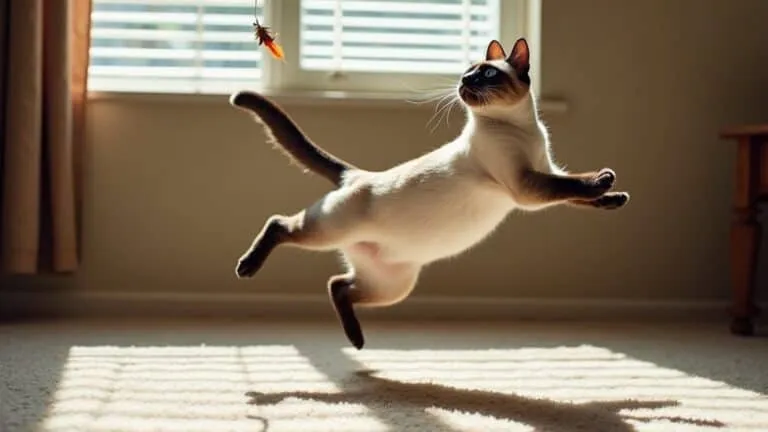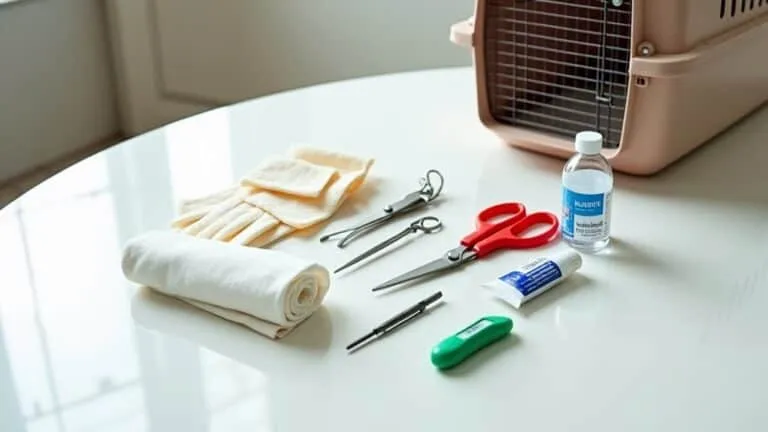The Best Fluffy Pancakes recipe you will fall in love with. Full of tips and tricks to help you make the best pancakes.
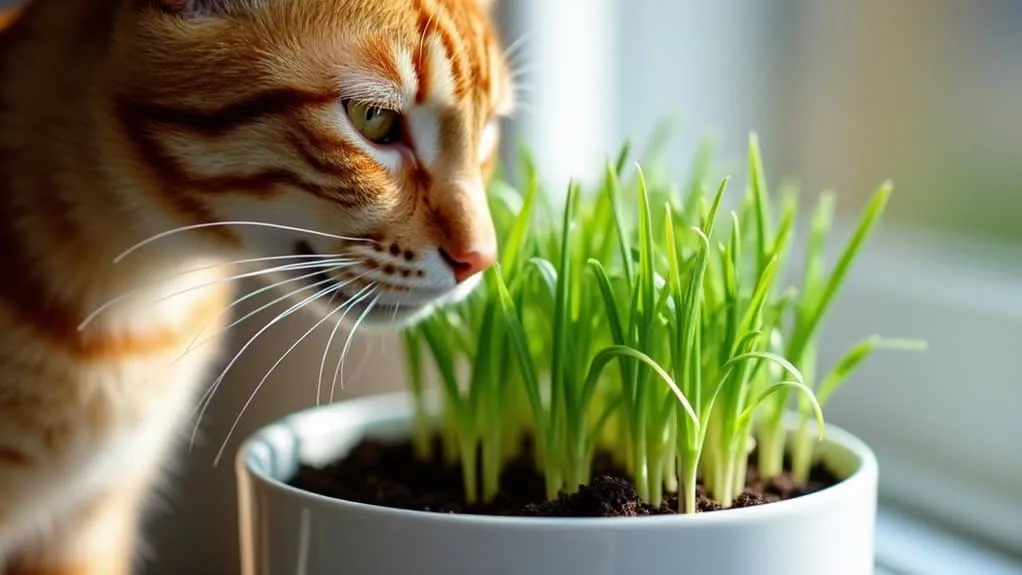
You've probably noticed your cat nibbling on your houseplants, but there's a safer and more enjoyable alternative: growing cat grass indoors. It's not just about keeping your feline friend away from toxic plants—it's about providing them with a natural, nutrient-rich treat that they'll love. Whether you're a seasoned plant parent or just starting out, creating your own mini cat garden is easier than you might think. Let's explore how you can transform a simple container of soil into your cat's favorite snacking spot.
The Ultimate Guide to Growing Cat Grass at Home
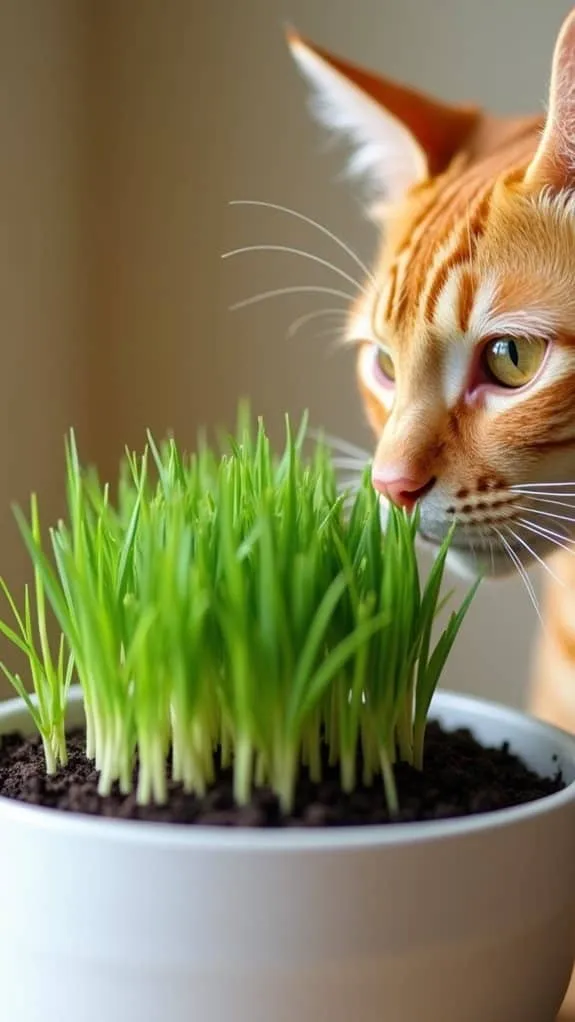
Growing your own cat grass indoors is a rewarding project that'll delight both you and your feline friend. When it comes to cat grass varieties, you've got plenty of options to choose from, including wheat, barley, rye, and oat. Your cats will get essential nutrients from nibbling these grasses, including fiber and vitamins, which aid in kidney function and overall health.
You'll want to start with high-quality, organic seeds from reliable sources – your seed sourcing strategy matters! Once planted, sprouts emerge within 2-3 days under proper conditions.
Set up your growing space with a sturdy container and nutrient-rich potting soil mixed with perlite. Make sure you're filling it about 1-2 inches from the top, giving those seeds plenty of room to stretch their roots.
Don't worry if you're not blessed with perfect lighting – cat grass is pretty forgiving and will grow even in lower light conditions. Just remember to keep the soil consistently moist but not waterlogged, and you'll have happy, healthy grass in no time. Regularly changing the water used for watering can also help ensure that the grass thrives.
Benefits of Cat Grass for Your Feline Friend
Your cat's health can get a natural boost when you add cat grass to their environment, as it's packed with essential vitamins, minerals, and fiber that support their digestive system. Additionally, providing cat grass can also contribute to your cat's overall wellness by promoting hydration levels, which is important for preventing urinary tract issues.
Growing wild across continents, cat grass represents what your feline companion would naturally consume in the wild. The natural fiber in cat grass works wonders for your furry friend's tummy, helping prevent hairballs and keeping their digestive tract running smoothly. Plus, you'll be giving your cat a safe, nutritious snack that's rich in antioxidants and folic acid, which means they'll be less likely to nibble on your houseplants.
Regular chewing of cat grass can provide trace mineral intake that supports your pet's overall wellness.
Natural Digestive Aid
While cats may seem mysterious in their ways, their natural instinct to munch on grass serves an essential purpose for their digestive health.
As one of nature's most effective natural remedies, cat grass helps your feline friend maintain a healthy digestive system by acting as a gentle, natural laxative and supporting regular bowel movements. Additionally, a balanced diet that includes fiber-rich options like cat grass can promote skin hydration and overall well-being.
You'll notice that your cat's feline preferences often lead them to nibble on grass when they need help with hairballs or indigestion. The enzymes and chlorophyll found in cat grass contribute significantly to your pet's overall wellness.
Growing your cat grass in pesticide-free soil ensures your indoor cat can safely enjoy this natural dietary supplement.
Cat grass works by helping move ingested fur through their system while providing essential fiber that aids digestion. It's like having a natural medicine cabinet right in your home!
Nutritional Value For Cats
Beyond its digestive benefits, cat grass packs a powerful nutritional punch that can boost your feline friend's overall health. You'll find essential vitamins A, B, C, and E, along with iron and amino acids that support your cat's metabolism and muscle development. Additionally, many of these vitamins, such as Vitamin E, play crucial roles in maintaining healthy skin and fur.
The folic acid content helps produce healthy blood cells, keeping your kitty's organs functioning at their best. Many cats are naturally drawn to cat grass because of its sweet, fresh leaves. While your cat may throw up after eating grass, this is actually a natural process that helps them eliminate indigestible materials.
When you grow cat grass indoors, you're providing your pet with a safe, pesticide-free source of these nutritional benefits. Whether it's wheatgrass, barley, oat, or rye grass, each variety offers its own mix of nutrients that complement your cat's regular diet.
Plus, you're giving them a natural way to stay hydrated and mentally stimulated. It's like offering your furry friend a fresh, vitamin-packed smoothie they can nibble on whenever they please!
Essential Materials and Tools for Growing Cat Grass
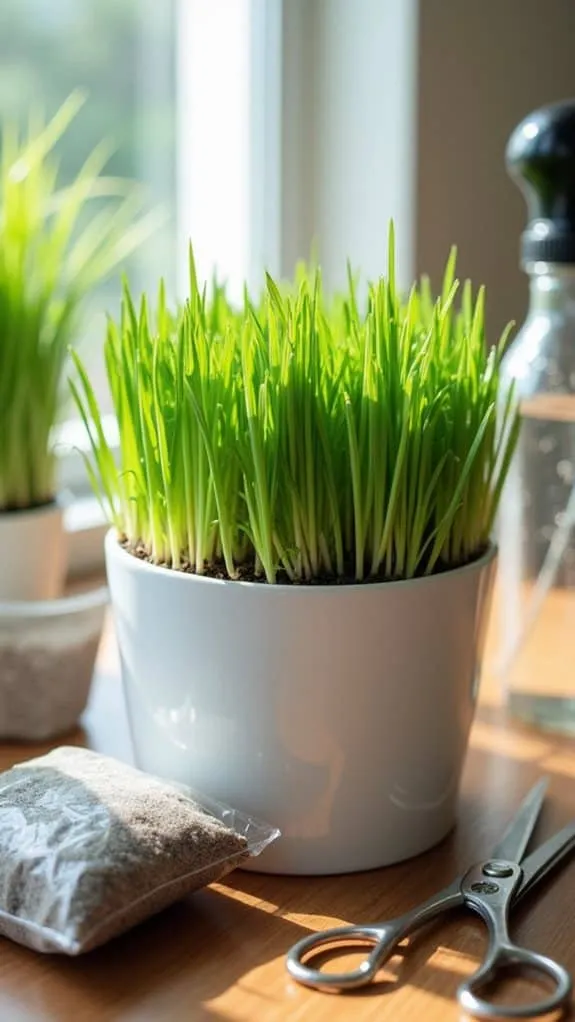
Starting a cat grass garden requires just a handful of essential materials that you'll find easy to gather.
You'll need a shallow, wide container – anything from a basic plastic pot to a decorative ceramic planter will work perfectly for your cat grass varieties. When selecting your container, make certain it has proper drainage to keep your kitty's garden healthy. Additionally, providing a cozy space for your cat while they enjoy their grass can enhance their kneading behavior.
For the growing medium, you can choose between organic potting soil with perlite or a soilless mix using growing stones as a natural alternative. Our preferred choice is Coco Coir Fiber soil pellets, which provide excellent aeration for strong root development.
Don't forget to pick up some quality seeds – wheatgrass, oat grass, or barley grass are all excellent choices your feline friend will love. Kneading can also indicate that your cat feels secure and relaxed, making these grasses a great addition to their environment.
You'll also need filtered water and a spray bottle for gentle watering. If your home doesn't get enough natural light, consider adding a grow light to guarantee your cat grass thrives.
Step-by-Step Planting Instructions
You'll want to start by getting your soil mix just right, filling your container to about 1-2 inches from the top with a well-aerated potting mix.
After moistening the soil with warm water, you'll sow your cat grass seeds about 1/4 inch deep, spacing them roughly an inch apart for ideal growth.
Once you've covered the seeds with a thin layer of soil and given them a gentle press, you're ready to water them carefully and begin the exciting journey from seeds to sprouts.
Soil Prep and Spacing
Planting cat grass begins with proper soil preparation and spacing, which sets the foundation for healthy growth and a happy feline companion.
You'll want to start with light, well-aerated soil that maintains proper soil moisture without becoming waterlogged. When you're ready to plant, aim for a seed depth of about 1/4 inch.
Here's your simple guide to success:
- Fill your container with soil mix, leaving 1/2" to 1" of space at the top
- Moisten the soil thoroughly before sowing any seeds
- Sprinkle seeds densely across the surface – they'll grow straight up
- Cover seeds lightly with additional soil mix
- Place plastic wrap with small holes over the top until sprouting begins. Regular maintenance of the cat's coat can also support their overall wellness during this time.
From Seeds to Sprouts
Now that your soil is ready, let's walk through the exciting process of transforming those tiny seeds into lush, cat-friendly grass.
Begin by filling your pot with soil, leaving about 1-2 inches of space at the top. For best seed selection, sprinkle your cat grass seeds evenly across the soil's surface, then cover them with a quarter-inch layer of fresh soil.
Here's an essential germination tip: keep the soil moist but not waterlogged before adding the seeds.
Once they're planted, partially cover the pot with plastic wrap and place it in a warm spot with indirect light, ideally between 72-78°F. Additionally, make sure to consult with a veterinarian if you plan to incorporate cat grass into your pet's diet, as they can provide valuable insights on nutrition.
You'll want to maintain consistent moisture during this phase, but don't worry – you'll see those first sprouts peeking through in just a day or two!
Creating the Perfect Growing Environment
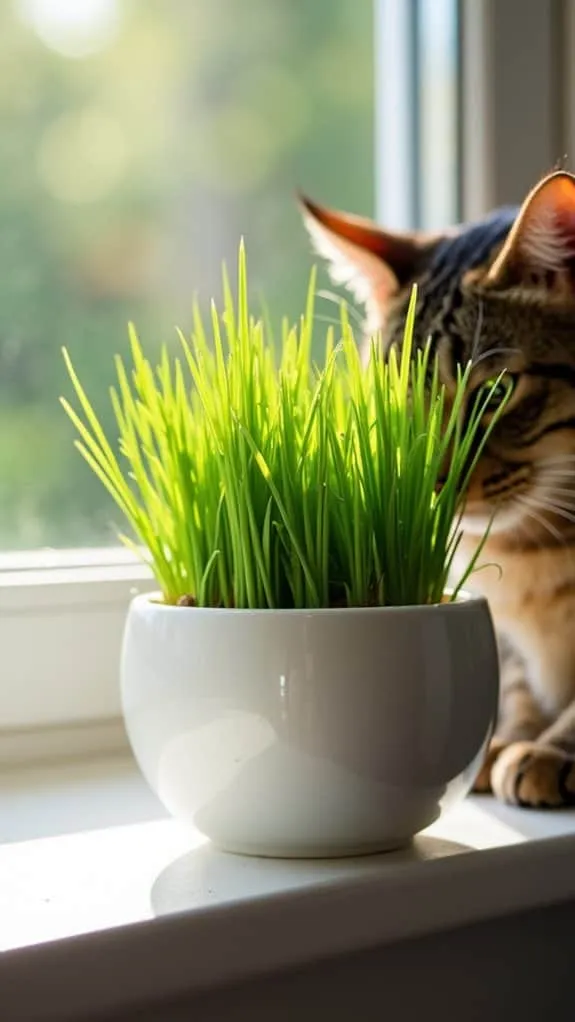
Creating the perfect environment for cat grass is like setting up a cozy home for a treasured houseplant.
You'll want to focus on light exposure and air circulation to help your grass thrive without any fuss.
Here's what your cat grass needs to flourish:
- A warm spot with temperatures between 72-78°F
- Indirect light, preferably near a window
- Good air flow to prevent mold growth
- Consistent moisture without overwatering
- Protection from direct sunlight during germination
You can grow this pet-friendly treat year-round by maintaining these conditions indoors. Additionally, proper care ensures that your cat grass remains healthy and safe for your furry friend to enjoy.
If natural light isn't abundant, don't worry – a grow light can provide the perfect substitute.
Daily Care and Maintenance Tips
Maintaining your cat grass doesn't have to feel like a daily chore, especially when you've got the right routine in place. Your feline friend will thank you for mastering these simple care techniques!
When it comes to watering techniques, less is more. Water your cat grass just once a week, and always check the soil's moisture level before adding more.
Your plant will thrive in bright, indirect light, so find that sweet spot away from harsh sunlight that could burn those tender blades. Remember, light requirements are essential – if you're dealing with limited natural light, a grow light can be your new best friend.
Keep an eye out for yellowing blades, and give them a trim to encourage fresh growth. Cats who nibble on grass may also experience improved oral health, which is vital for preventing dental issues that can affect overall well-being.
With these simple steps, you'll have a happy, healthy patch of cat grass your kitty can't resist!
Harvesting and Serving Cat Grass
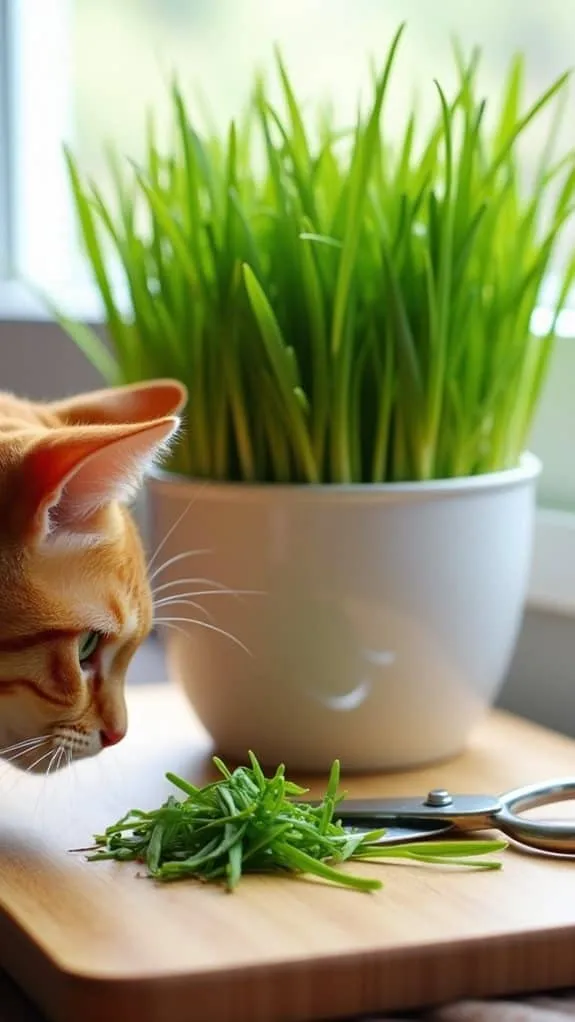
Once your cat grass reaches a height of 4-6 inches, it's ready for its first haircut! Your feline friend will thank you for mastering these simple harvesting techniques and serving suggestions.
Regular trimming every 7-10 days keeps the grass healthy and encourages fresh growth. To ensure your cat feels comfort and security, place the grass pot in a cozy corner where your kitty loves to hang out.
For the best experience, follow these cat-approved tips:
- Set up the grass pot in a cozy corner where your kitty loves to hang out
- Use clean, sharp scissors to trim the grass about halfway down
- Remove any yellowed or wilted blades during harvest
- Place the freshly cut grass in a shallow dish for easy access
- Keep a consistent harvesting schedule to maintain ideal growth
Common Growing Challenges and Solutions
While growing cat grass brings joy to your feline friends, you'll likely encounter some common challenges along the way. From finding the right soil types to managing common pests, success requires attention to detail and quick problem-solving skills.
You'll want to watch out for overwatering, which can quickly lead to root rot, while underwatering leaves your grass looking sad and brittle. If you notice your cat grass looking pale or leggy, it's probably crying out for more indirect sunlight.
Keep an eye out for unwanted visitors too – those tiny pests can wreak havoc if left unchecked!
Remember to use well-draining soil and maintain consistent moisture levels without drowning your plants. With proper air circulation and temperature control, you'll be well on your way to growing healthy, cat-approved grass that'll make both you and your furry friend smile.
Alternative Growing Methods and Techniques
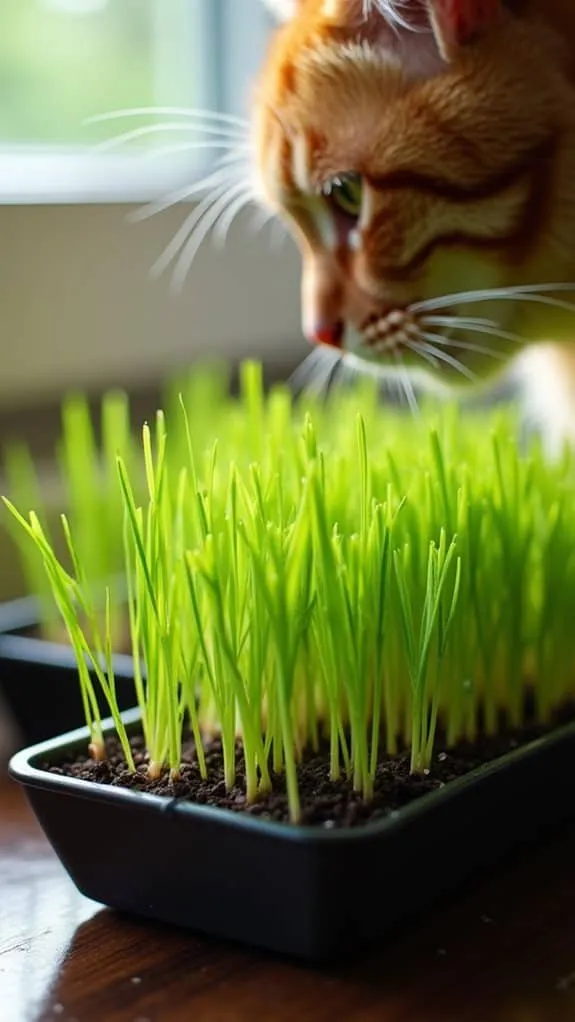
Growing cat grass doesn't have to follow traditional methods, as several innovative approaches can make the process easier and more enjoyable for both you and your feline friends.
You'll find success with various container types and lighting options that suit your space and schedule.
Consider these creative alternatives to boost your cat grass growing game:
- Mix coconut coir with perlite for perfect moisture balance
- Try window-mounted planters to maximize natural light exposure
- Use heavy, stable containers to prevent tip-overs from curious paws
- Rotate multiple nursery pots for continuous fresh growth
- Install umbrella-shaped grow lights for consistent indoor results
When you're ready to experiment, remember that soilless mixes often work better than traditional soil, and indirect lighting can be just as effective as direct sunlight.
Your cats will thank you for the effort!
Final Thoughts
Growing cat grass is like creating a mini-jungle paradise for your furry friend. You'll love watching your kitty's eyes light up as those first green shoots emerge, and you'll feel proud knowing you're providing a natural, healthy treat. With just a little patience and care, you've created something special that'll keep your cat purring with delight. So grab those seeds and get growing – your feline gardening adventure awaits!

